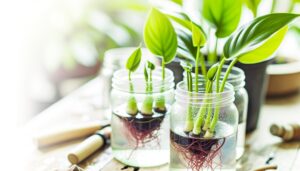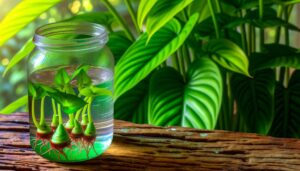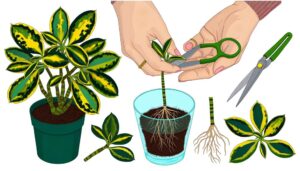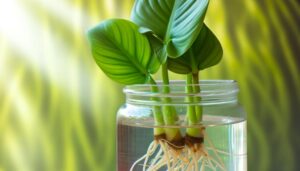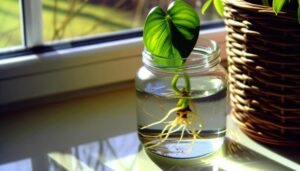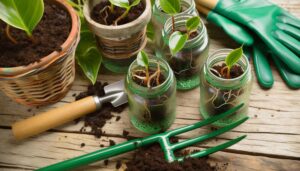Elephant Ear Philodendron Propagation: Step-by-Step Guide!
Elephant Ear Philodendron propagation calls for selecting a healthy, robust parent plant free from pests and diseases. Utilize sterilized pruning shears and rooting hormone in a clean, well-lit workspace.
Choose a cutting with a node and vibrant foliage, making a clean cut just below the node. Apply rooting hormone and allow the cutting to callus before planting.
Place the cutting in a well-draining potting mix, maintaining ideal temperature and humidity for root development. Move cuttings to soil once roots reach 5-7 cm.
Monitor for root formation and new leaf growth to guarantee successful propagation. For a detailed guide, further details follow.
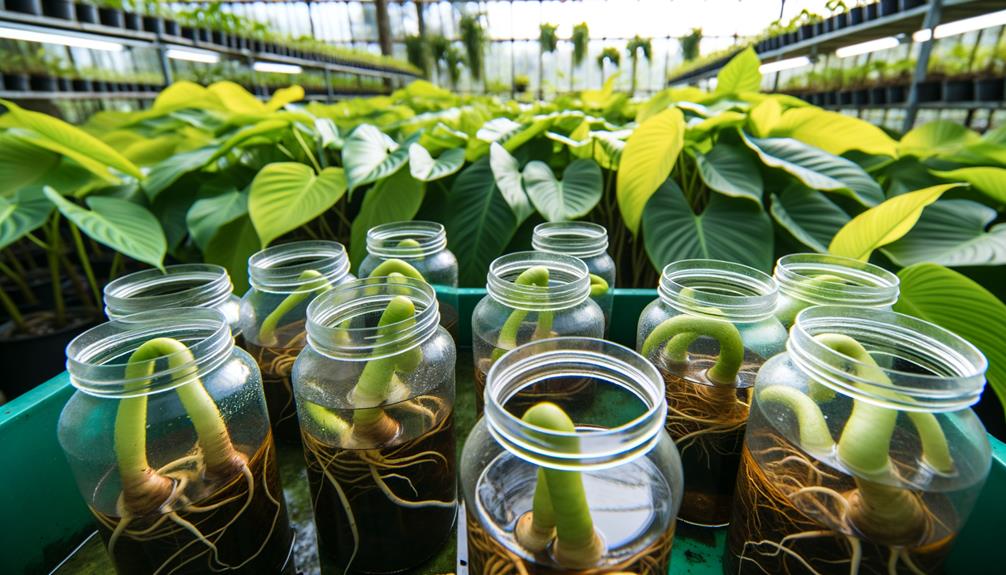
Key Takeaways
- Select a vigorous parent plant with no signs of damage or pests.
- Use sterilized pruning shears to cut a healthy stem below a node.
- Apply rooting hormone to the cut end and allow it to callus.
- Plant the cutting in well-draining soil and maintain optimal humidity and temperature.
- Monitor for root development and new growth, ensuring consistent moisture levels.
Choosing Healthy Parent Plant
Selecting a strong and disease-free Philodendron bipinnatifidum is crucial for successful propagation. The health of the parent plant directly influences the vigor of the cuttings.
Begin by inspecting the foliage for signs of chlorosis, necrosis, or pest infestation. Leaves should exhibit a healthy green color with no deformities.
Examine the stems for firmness and absence of lesions or discolorations. The root system should be white and fibrous, indicating active growth and absence of root rot.
Make sure the plant is well-hydrated but not waterlogged, as overwatering can lead to pathogenic infections.
A parent plant that displays excellent vigor and health will greatly increase the likelihood of successful root establishment and subsequent growth in the propagated cuttings.
Gathering Necessary Tools
To propagate an Elephant Ear Philodendron, you will need:
- Sterilized pruning shears
- Rooting hormone
- Clean container
- Well-draining potting mix
Begin by sterilizing your pruning shears with isopropyl alcohol to prevent pathogen transmission. Select a rooting hormone, preferably one containing indole-3-butyric acid (IBA), to enhance root development.
Prepare a clean container, making sure it has adequate drainage holes to prevent waterlogging. Choose a well-draining potting mix, such as a blend of peat moss, perlite, and pine bark, to provide ideal aeration and moisture retention.
Assemble these tools in a well-lit workspace to facilitate ease of use. Proper preparation of tools ensures a higher success rate in propagating your Elephant Ear Philodendron.
Identifying Suitable Cutting
A suitable cutting for propagating an Elephant Ear Philodendron should be chosen from a healthy, mature plant, making sure the section includes at least one node and a few leaves. Identifying the best cutting involves examining the plant for strong growth patterns and vibrant foliage. The node, a vital point of root development, is an important part of the cutting.
| Criteria | Description | Importance |
|---|---|---|
| Plant Health | Free from pests and diseases | Ensures vigorous growth |
| Node Presence | At least one node | Root initiation site |
| Leaf Count | Minimum of a few leaves | Photosynthesis and energy |
| Stem Thickness | Moderate to thick | Structural support |
Carefully selecting a cutting that meets these criteria increases the chances of successful propagation and robust plant development.
Making the Cut
To initiate the cutting process, select healthy stems exhibiting robust growth and devoid of any signs of disease or pest infestation. Utilize sterilized, sharp pruning shears to make a precise incision just below a node, ensuring a clean cut that promotes best root development.
Proper technique is essential to minimize tissue damage and facilitate successful propagation.
Selecting Healthy Stems
Identifying top stems for propagation involves selecting those with strong, disease-free leaves and a minimum of two to three nodes, as these nodes are crucial for root development.
Carefully examine the stem for signs of vitality, guaranteeing it displays a healthy, green hue without any necrotic tissue or discoloration. Check for pest infestations by inspecting both the upper and lower leaf surfaces.
Ideal stems should be semi-mature, neither too young nor overly hardened. Confirm the selected stem is at least 4-6 inches long to provide sufficient material for successful propagation.
Prioritize stems that are actively growing, as indicated by new leaf emergence, ensuring the plant’s metabolic processes support vigorous root formation post-cutting.
Proper Cutting Techniques
Utilizing sterile, sharp pruning shears or a clean, disinfected knife is essential to guarantee a precise, clean cut that minimizes tissue damage and reduces the risk of pathogen transmission.
Begin by identifying a healthy stem with at least two nodes. Position the shears or knife just below a node, making an angled cut of approximately 45 degrees to enhance surface area for root development. Apply steady pressure to make a swift, clean incision.
Immediately after cutting, dip the cut end in a rooting hormone to facilitate root growth. Allow the cuttings to callus over for a few hours before planting.
This methodical approach ensures optimal propagation success and maintains the plant’s health and vigor.
Preparing the Cutting
Consistently verify that the pruning shears or a sterilized knife are meticulously clean to prevent any potential contamination when making a precise cut just below a node on the Elephant Ear Philodendron stem.
Select a healthy, mature stem with at least one node and several leaves. Confirm the node, an essential site for root development, is intact.
After cutting, remove any lower leaves to expose the node, facilitating better rooting conditions.
Allow the cutting to air-dry for several hours to form a callus over the cut end, which mitigates the risk of fungal infections and promotes successful rooting.
This preparation ensures the cutting is primed for the subsequent propagation stage, optimizing the likelihood of vigorous root formation.
Rooting in Water
To initiate the rooting process of an Elephant Ear Philodendron cutting, it is critical to guarantee the cutting is properly sanitized and trimmed below a node.
The water quality plays a pivotal role; using distilled or dechlorinated water can prevent potential pathogens and mineral buildup.
Observing the root growth timeline, roots typically begin to emerge within 2-4 weeks, indicating successful propagation.
Water Quality Importance
Ensuring perfect water quality is essential for successful rooting, as impurities and contaminants can hinder root development and encourage pathogen growth.
Utilize distilled or filtered water to minimize chlorine, chloramine, and heavy metal presence. Conduct regular water changes, ideally every 3-5 days, to sustain best oxygen levels and prevent microbial colonization.
Monitor water temperature, maintaining it between 20°C and 25°C (68°F and 77°F), as drastic fluctuations can stress the cuttings. Additionally, avoid direct sunlight on the container to mitigate algae proliferation.
Employing a transparent vessel allows for monitoring the root development while ensuring no stagnation occurs. Implementing these measures will create a conducive environment for the philodendron’s adventitious roots to establish robustly.
Root Growth Timeline
Maintaining perfect water conditions sets the stage for observing the root growth timeline, typically starting with the emergence of small root nodules within the first 7-14 days.
During this initial phase, guarantee the water is free of contaminants and changed every few days to prevent stagnation and microbial growth.
By the third week, these nodules elongate into primary roots, characterized by their white, fibrous structure. Best temperatures (20-25°C) and indirect lighting conditions are vital to facilitate this development.
Within 4-6 weeks, secondary roots form, branching out and increasing absorption capacity. This period is essential for ensuring the cutting’s shift to soil, which should be done once roots are robust, approximately 5-7 cm in length.
Planting in Soil
To successfully plant Elephant Ear Philodendron cuttings in soil, it is important to ensure that the medium is well-draining, rich in organic matter, and slightly acidic to neutral in pH. Begin by selecting a high-quality potting mix that contains components such as perlite, peat moss, and compost. Sterilize the soil to eliminate pathogens by baking it at 180°F for 30 minutes.
Next, plant the cutting, making sure that at least one node is buried beneath the soil surface. Water thoroughly to settle the soil around the cutting.
Essential soil components:
- Perlite: Enhances aeration and drainage.
- Peat moss: Retains moisture and provides acidity.
- Compost: Improves nutrient content.
- Sand: Ensures proper drainage.
Monitor for signs of new growth, indicating successful establishment.
Providing Optimal Conditions
Perfect conditions for Elephant Ear Philodendron propagation involve sufficient light, appropriate temperature, and consistent humidity levels to promote strong growth and development.
Guaranteeing these parameters involves placing the cuttings in an environment with indirect, bright light, avoiding direct sunlight which can cause leaf scorch.
Best temperature ranges between 65-75°F (18-24°C), as temperatures below 60°F (15°C) can hinder root development.
Maintaining humidity levels around 60-70% is optimal; this can be achieved by misting the leaves or using a humidity tray.
Additionally, providing well-draining soil with high organic content, such as a mix of peat moss and perlite, ensures adequate drainage and root aeration.
Regularly check moisture levels to prevent waterlogging, which can lead to root rot.
Monitoring Growth
Regular observation and documentation of Elephant Ear Philodendron cuttings are crucial for evaluating root development and overall plant health. Monitoring involves meticulous inspection of several parameters to ensure optimal growth conditions.
Key aspects to observe include:
- Root Formation: Check for the emergence of new roots from the node, an indication of successful propagation.
- Leaf Development: Assess the growth of new leaves, noting any changes in color or texture, which reflect the plant’s importance.
- Moisture Levels: Maintain consistent moisture in the growing medium, avoiding both waterlogging and drought conditions.
- Pest Inspection: Regularly inspect for signs of pest infestation, such as discolored leaves or unusual markings, to preemptively address any issues.
These practices foster healthy propagation and robust plant development.
Troubleshooting Common Issues
When propagating Elephant Ear Philodendron, addressing common issues such as root rot, leaf discoloration, and pest infestations is vital to guarantee successful plant development.
Root rot typically arises from overwatering; ensure the substrate has good drainage and allow it to dry adequately between waterings.
Leaf discoloration, often yellowing, may indicate nutrient deficiencies or improper light exposure; provide balanced fertilization and adjust light conditions accordingly.
Pest infestations, such as spider mites or aphids, can be mitigated through regular inspection and application of neem oil or insecticidal soap.
Additionally, maintaining ideal humidity and airflow can prevent fungal issues.
Regular monitoring and prompt intervention are essential to sustain healthy growth and vigorous propagation of Elephant Ear Philodendron.
Conclusion
The propagation of the Elephant Ear Philodendron is a delicate process that involves several key steps. First, a healthy parent plant must be carefully chosen. The next step is to skillfully cut a suitable portion of the plant for propagation. This cutting must then be prepared properly for planting in the soil.
Ensuring that the plant is placed in an environment with the right levels of humidity and temperature is crucial for its growth. Regular monitoring of the plant and addressing any common issues that may arise are essential for its well-being. By following these steps diligently, one can successfully cultivate a lush and thriving Elephant Ear Philodendron.

